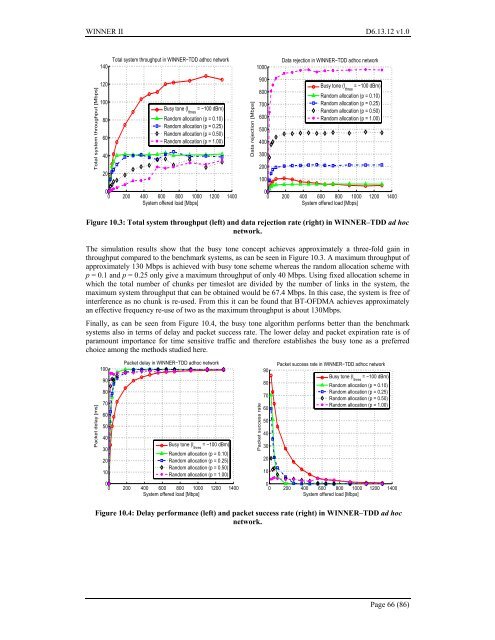IST-4-027756 WINNER II D6.13.12 v1.0 Final CG “local area ...
IST-4-027756 WINNER II D6.13.12 v1.0 Final CG “local area ...
IST-4-027756 WINNER II D6.13.12 v1.0 Final CG “local area ...
Create successful ePaper yourself
Turn your PDF publications into a flip-book with our unique Google optimized e-Paper software.
<strong>WINNER</strong> <strong>II</strong> <strong>D6.13.12</strong> <strong>v1.0</strong>140Total system throughput in <strong>WINNER</strong>−TDD adhoc network1000Data rejection in <strong>WINNER</strong>−TDD adhoc networkTotal system throughput [Mbps]12010080604020Busy tone (I thres= −100 dBm)Random allocation (p = 0.10)Random allocation (p = 0.25)Random allocation (p = 0.50)Random allocation (p = 1.00)Data rejection [Mbps]900800700600500400300200100Busy tone (I thres= −100 dBm)Random allocation (p = 0.10)Random allocation (p = 0.25)Random allocation (p = 0.50)Random allocation (p = 1.00)00 200 400 600 800 1000 1200 1400System offered load [Mbps]00 200 400 600 800 1000 1200 1400System offered load [Mbps]Figure 10.3: Total system throughput (left) and data rejection rate (right) in <strong>WINNER</strong>–TDD ad hocnetwork.The simulation results show that the busy tone concept achieves approximately a three-fold gain inthroughput compared to the benchmark systems, as can be seen in Figure 10.3. A maximum throughput ofapproximately 130 Mbps is achieved with busy tone scheme whereas the random allocation scheme withp = 0.1 and p = 0.25 only give a maximum throughput of only 40 Mbps. Using fixed allocation scheme inwhich the total number of chunks per timeslot are divided by the number of links in the system, themaximum system throughput that can be obtained would be 67.4 Mbps. In this case, the system is free ofinterference as no chunk is re-used. From this it can be found that BT-OFDMA achieves approximatelyan effective frequency re-use of two as the maximum throughput is about 130Mbps.<strong>Final</strong>ly, as can be seen from Figure 10.4, the busy tone algorithm performs better than the benchmarksystems also in terms of delay and packet success rate. The lower delay and packet expiration rate is ofparamount importance for time sensitive traffic and therefore establishes the busy tone as a preferredchoice among the methods studied here.Packet delay [ms]1009080706050Packet delay in <strong>WINNER</strong>−TDD adhoc network4030Busy tone (I thres= −100 dBm)Random allocation (p = 0.10)20Random allocation (p = 0.25)Random allocation (p = 0.50)10Random allocation (p = 1.00)00 200 400 600 800 1000 1200 1400System offered load [Mbps]Packet success rate908070605040302010Packet success rate in <strong>WINNER</strong>−TDD adhoc networkBusy tone (I = −100 dBm)thresRandom allocation (p = 0.10)Random allocation (p = 0.25)Random allocation (p = 0.50)Random allocation (p = 1.00)00 200 400 600 800 1000 1200 1400System offered load [Mbps]Figure 10.4: Delay performance (left) and packet success rate (right) in <strong>WINNER</strong>–TDD ad hocnetwork.Page 66 (86)
















